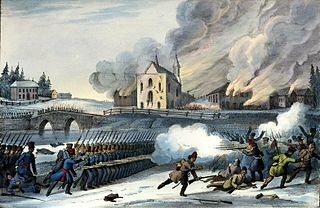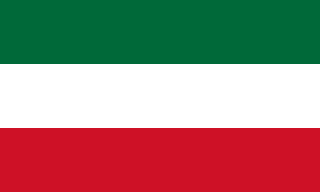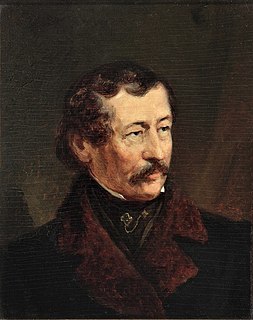The following is an incomplete bibliography of the 1837-1838 insurrections in Lower Canada in the English and French languages, by publication date and document type.

Saint-Jean-Baptiste Day, also known in English as St John the Baptist Day, is a holiday celebrated on June 24 in the Canadian province of Quebec and by French Canadians across Canada and the United States. It was brought to Canada by French settlers celebrating the traditional feast day of the Nativity of Saint John the Baptist. It was declared a public holiday in Quebec in 1925, with publicly financed events organized province-wide by a Comité organisateur de la fête nationale du Québec.

Louis-Joseph Papineau, born in Montreal, Quebec, was a politician, lawyer, and the landlord of the seigneurie de la Petite-Nation. He was the leader of the reformist Patriote movement before the Lower Canada Rebellion of 1837–1838. His father was Joseph Papineau, also a politician in Quebec. Papineau was the eldest of eight children and was the grandfather of the journalist Henri Bourassa, founder of the newspaper Le Devoir. Louis-Joseph Papineau is commemorated by a public artwork installed in the metro station, Papineau that serves the street named for his father Joseph Papineau. L'École Secondaire Louis-Joseph Papineau in Montreal was named after him.

Sir Louis-Hippolyte MénardditLa Fontaine, 1st Baronet, KCMG was a Canadian politician who served as the first Premier of the United Province of Canada and the first head of a responsible government in Canada. He was born in Boucherville, Lower Canada in 1807. A jurist and statesman, La Fontaine was first elected to the Legislative Assembly of Lower Canada in 1830. He was a supporter of Papineau and member of the Parti canadien. After the severe consequences of the Rebellions of 1837 against the British authorities, he advocated political reforms within the new Union regime of 1841.

The Lower Canada Rebellion, commonly referred to as the Patriots' War in French, is the name given to the armed conflict in 1837–38 between rebels and the colonial government of Lower Canada. Together with the simultaneous rebellion in the neighbouring colony of Upper Canada, it formed the Rebellions of 1837–38.

This section of the Timeline of Quebec history concerns the events in British North America relating to what is the present day province of Quebec, Canada between the time of the Constitutional Act of 1791 and the Act of Union 1840.

Robert Nelson was an Anglo-Quebecer physician and a leading figure in the Lower Canada Rebellion in 19th century Quebec.

Wolfred Nelson was the mayor of Montreal, Quebec, from 1854 to 1856.

Ludger Duvernay, born in Verchères, Quebec, was a printer by profession and published a number of newspapers including the Gazette des Trois-Rivières, the first newspaper in Lower Canada outside of Quebec City and Montreal, and also La Minerve, which supported the Parti patriote and Louis-Joseph Papineau in the years leading up to the Lower Canada Rebellion.
The Red Party was a political group that contested elections in the Eastern section of the Province of Canada. It was formed around 1847 by radical French-Canadians inspired by the ideas of Louis-Joseph Papineau, the Institut canadien de Montréal, and the reformist movement led by the Parti patriote of the 1830s.

National Patriots' Day is a statutory holiday observed annually in the Canadian province of Quebec, on the Monday preceding 25 May. The holiday was established by the Lieutenant Governor of Quebec-in-Council in 2003, according to the Parti Quebecois premier Bernard Landry: "to underline the importance of the struggle of the patriots of 1837–1838 for the national recognition of our people, for its political liberty and to obtain a democratic system of government." Before 2003, the Monday preceding 25 May of each year was unofficially the Fête de Dollard, a commemoration initiated in the 1920s to coincide with Victoria Day, a federal holiday occurring annually on the same date.

Lt.-Colonel The Hon. Clément-Charles Sabrevois de Bleury of Montreal was a soldier, seigneur, lawyer, politician, newspaper founder and noted duellist. Bleury Street in Montreal is named for him. His nephews included the Prime Minister of Quebec, Sir Charles Boucher de Boucherville, and Louis-Tancrède Bouthillier, from whose house the City of Outremont takes its name.

The Assembly of the Six Counties was an assembly of Patriote leaders and approximately 6,000 followers held in Saint-Charles, Lower Canada on October 23 and October 24, 1837, despite the June 15 Proclamation of the government forbidding public assemblies.

The Colonne de la liberté was a symbol of the Patriote movement erected in Saint-Charles, Lower Canada on October 23, 1837. Its name is identical to the column that marked the history of the French Revolution. In 1982, because of the Comité des Patriotes and the Quebec Ministry of Culture, a replica was raised on its presumed original location and still stands today.

The Patriote popular assemblies gathered supporters and leaders of the Patriote movement and the Parti patriote in 1837 Lower Canada. The assemblies, concentrated in the Montreal and Montérégie region, saw votes on resolutions and speeches of some of Lower Canada's most reputed orators.

The Pied-du-Courant Prison is a prison museum in Montreal, Quebec, Canada near the Saint Lawrence River and the Jacques-Cartier Bridge.

The Patriote flag was used by the Patriote movement in Lower Canada between 1832 and 1838.

Louis-Antoine Dessaulles was a Quebec seigneur, journalist and political figure.
This Bibliography of Louis-Joseph Papineau, is an incomplete list of all things written by or published about Louis-Joseph Papineau in either French or English, original or translation.

Louis-Joseph-Amédée Papineau, or Amédée Papineau (1819–1903) was a writer and Québecois patriot and present at the meeting at which the Société des Fils de la Liberté was founded. He was the eldest son of Louis-Joseph Papineau, a leader in the Rebellion of 1837 in Lower Canada, and was involved in the rebellion himself. His father was forced to flee, and Amédée followed him to Saratoga Springs, New York. Between 1837 and 1842, he drew up the first four books of his personal journal as Journal d'un Fils de la Liberté in which he chronicled the events of the 1837 rebellion and his life in exile.

Napoléon Aubin, christened Aimé-Nicolas, was born from a Swiss family in Chêne-Bougeries, a district of Geneva, at the time a territory of France. He was a journalist, writer, publisher, scientist, musician and lithographer.